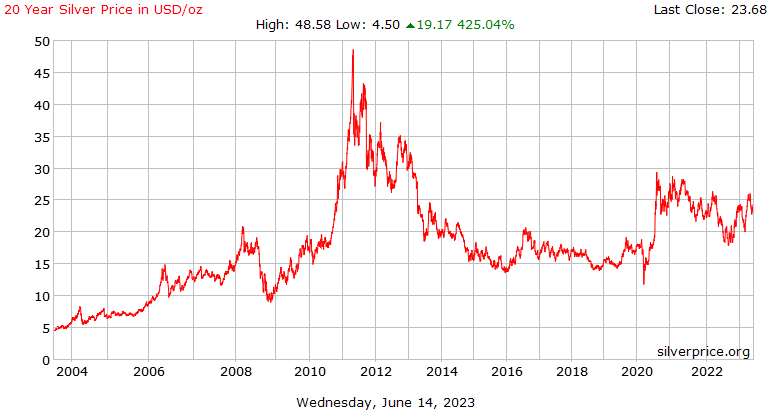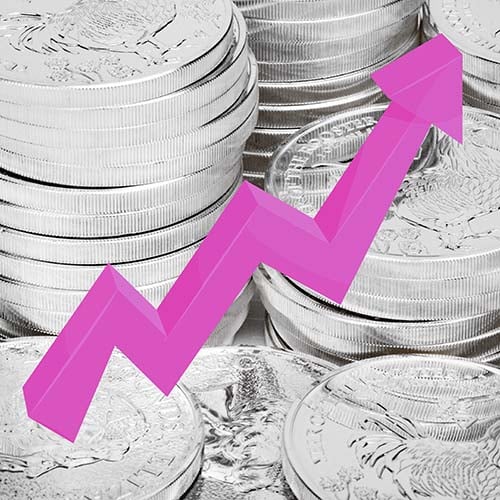Silver Price Per Gram Last Year

Silver is an invaluable asset, often referred to as “poor man’s gold” due to its relative affordability compared to other precious metals. As the global economy faces uncertainty, investors have been turning towards silver as a safe haven asset in 2020 due to its stability and potential for growth.
This article will explore the factors influencing the price of silver per gram last year and provide insights into how this affected the silver market, including investment strategies that can be used to capitalize on this trend.
By analyzing data from various sources such as the World Bank and International Monetary Fund, we will gain a better understanding of how these factors interact and what implications they may have for investors.
Overview of the Silver Market
This overview of the silver market provides valuable insight into its dynamics and performance. The metal is widely viewed as a safe-haven asset, often moving inversely to other markets due to its inverse correlation with riskier assets such as stocks and equities.
Last year, the spot price of silver exhibited surprising levels of volatility throughout 2020. Silver prices began the year at around $18 per ounce before reaching an all-time high of nearly $30 in August 2020. This surge was driven by multiple factors including ongoing US-China trade tensions, increased demand from investors seeking protection from inflationary pressures, and strong economic growth expectations for 2021. However, prices soon reversed course and dropped back down to pre-pandemic levels by the end of 2020.
Despite this decline, the average silver price per gram over last year remained higher than it had been in previous years due to higher global demand for physical bullion bars and coins as well as stronger industrial consumption trends for electronics manufacturing and jewelry production.
Factors Influencing the Price of Silver
Various factors have been found to affect the fluctuation of the precious metal’s value over time. These include:
- Economic Factors:
- Interest Rates – When interest rates increase, investors tend to invest less in silver as they receive better returns from other investments. This reduces the demand for silver and leads to a decrease in its price.
- Inflation – Higher inflation causes an increase in the demand for precious metals like silver, leading to an increase in its price.
- Political Factors:
- Sanctions – Sanctions imposed by governments on certain countries can lead to a decrease in global demand for silver, resulting in a drop of its prices.
- Speculation – Speculative trading by traders can result in large fluctuations of silver prices depending on the market sentiment towards it.
These factors are interrelated and influence each other, causing significant changes in the price of silver over time. Thus, it is important for investors and traders to be aware of all these factors when making their decisions related to investing or trading with this precious metal.
Silver Price Per Gram in 2020
The year 2020 saw a remarkable upsurge in the worth of silver, with its value reaching an unprecedented level.
The average price per gram of silver stood at $0.78 in January 2020 and increased to $1.21 in December 2020, marking a 54.5% increase over the course of the year.
This was largely due to factors such as increased global demand for industrial metals, fluctuating currency values, and heightened investor interest in safe-haven investments amid economic uncertainty caused by the COVID-19 pandemic.
Silver prices experienced significant volatility during the year, peaking at $1.56 per gram in August before declining to $1.17 by November and then recovering slightly to close out the year at $1.21 per gram – still well above its opening price of $0.78 from January 2020.
Despite this volatility, Silver maintained its status as one of the most attractive investments throughout 2020 due to its ability to hedge against inflation and act as a reliable store of value during times of financial instability or crisis in other markets or asset classes.
Effects of the Price Increase on the Silver Market
The significant appreciation of silver in 2020 had far-reaching implications for the silver market. As prices rose to over $25 USD per ounce, a number of investors, both retail and institutional, took advantage of the price increase to pursue profits. Silver has historically been seen as a safe haven asset during periods of economic uncertainty, and with global events such as Brexit and US-China trade tensions driving fears of an impending recession, many investors believe that silver could be an attractive investment opportunity in the long term.
At the same time, there were also some negative effects from this price increase. The increased demand for physical silver caused shortages in supply which further drove up prices and made it more difficult for investors to purchase at lower rates. Additionally, traders who had shorted or sold derivatives contracts on silver saw their positions become increasingly unprofitable as prices climbed higher. These losses may have led to liquidity issues for some traders since they would need to buy back these contracts at higher costs than when they originally sold them.
Overall, while there were many positive outcomes from this price increase in terms of investor gains and long-term opportunities for growth, it is important to note that there were also some potentially negative consequences associated with it as well.
Investing Strategies for Silver
Investors may consider a variety of strategies to capitalize on the silver market, ranging from traditional long-term investments to more volatile short-term plays. To make the most of this asset class, investors should have a clear understanding of their risk tolerance and investment goals.
Long-term investments in silver require patience and are well suited for those with a lower risk appetite looking to diversify their portfolio over time. Silver ETFs are one popular option allowing investors to gain exposure to the metal without having to physically purchase it. The largest ETF is iShares Silver Trust (SLV), which tracks spot prices closely and charges an expense ratio of 0.50%.
In contrast, short-term traders may look at options such as futures contracts that allow them to take advantage of movements in price over a shorter period. Futures offer more leverage than ETFs but involve greater risk due to expiry dates and potential gaps in price between when positions are opened and closed. Additionally, margin requirements can be expensive for leveraged positions so investors need to factor this into their strategy when considering these products.
Ultimately, investing in silver requires careful consideration of both the individual’s risk profile and objectives before putting any money into play in order maximize potential returns while minimizing losses along the way.
Frequently Asked Questions
What is the best way to store silver?
Storing silver is an important consideration for those investing in the precious metal. Silver, being a soft metal, can be easily scratched and tarnished if not properly stored.
For long-term storage, the ideal environment should be cool, dry, and dark with little fluctuations in temperature or humidity. The best storage solution may depend on the individual’s needs and preferences.
Options include storing silver coins and bars in a safe deposit box at a bank or other financial institution; purchasing specialised holders such as tubes or cases designed specifically for coins; using airtight containers to prevent tarnishing; or investing in professional coin grading services that provide secure plastic cases for coins.
Regardless of which option is chosen, it is important to take measures to protect your investment by ensuring proper storage of your silver items.
What are the potential risks of investing in silver?
Investing in silver can be a risky endeavor, as fluctuations in the market value of silver can have a significant effect on an investor’s return.
Silver prices are affected by both macroeconomic factors such as currency exchange rates and global supply and demand, as well as microeconomic factors like regional economic development and political instability.
Additionally, investors may encounter liquidity risks when attempting to convert their physical holdings of silver into cash.
Furthermore, the storage costs associated with holding physical silver can add up over time, eroding potential returns for those investing without careful consideration for these expenses.
Is silver a good long-term investment option?
Silver is often considered a good long-term investment option due to its historical performance and potential for appreciation.
Silver has outperformed inflation over the long term, with the London Bullion Market Association (LBMA) Silver Price Index showing an average annual price increase of 4.6% per year from 1986-2020.
Additionally, silver is seen as a hedge against economic uncertainty, due to its low correlation with other asset classes.
Its volatility also gives investors further opportunities to capitalize on short-term trades by taking advantage of sharp price movements in either direction.
However, like any investment vehicle, there are associated risks that should be taken into consideration before investing in silver.
What are the different types of silver products available?
Silver is a precious metal that has been popular since ancient times. It can be found in many forms, such as coins, bars, jewelry and other decorative items.
Silver products come in different shapes and sizes, ranging from small coins to large bars. The most popular silver products are coins and bullion bars which have both numismatic value as well as investment value due to their high purity levels.
Silver jewelry is also popular among collectors due to its aesthetic appeal and the fact that it often contains rare or antique pieces with unique designs or patterns.
Finally, silverware such as cutlery or serving dishes are also sought after due to their beauty and elegance.
What is the historical price of silver?
Silver is one of the world’s most precious metals and its price has fluctuated dramatically in recent years.
Historically, silver prices have been highly volatile, with prices reaching as high as $50 per ounce in 1980.
Since then, however, the price has dropped significantly to an average of around $15 per ounce during the first half of 2020.
The exact historical price of silver depends on a variety of factors such as supply and demand, economic conditions, geopolitical events, and currency values.
Additionally, because silver is subject to industrial use and jewelry production it can be influenced by changes in fashion trends or technological innovations related to its uses.
Conclusion
The silver market has experienced a significant increase in price over the past year. This was due to a variety of factors, including fluctuating demand for industrial applications as well as higher prices for gold and other precious metals.
In 2020, the average price for one gram of silver was around $0.61 USD. This marks an 8% increase from 2019, indicating that there is an overall upward trend in the price of silver.
As a result, investors have had to adjust their strategies to capitalize on this trend and ensure they remain profitable in the long-term. Interestingly, this price increase has also resulted in increased production of silver coins and bars with many countries minting them at record highs in 2020.






